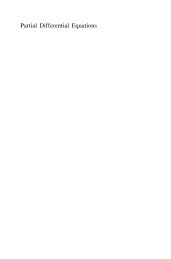a Matlab package for phased array beam shape inspection
a Matlab package for phased array beam shape inspection
a Matlab package for phased array beam shape inspection
Create successful ePaper yourself
Turn your PDF publications into a flip-book with our unique Google optimized e-Paper software.
4.6 Parseval’s theorem 19<br />
closed <strong>for</strong>m as a product of two Direchlet kernels:<br />
AF =<br />
M∑<br />
x−1<br />
m x=0<br />
M<br />
∑ y−1<br />
e iΨxmx<br />
m y=0<br />
e iΨymy (50)<br />
= e iΦ M x M y · diric(Ψ x , M x ) · diric(Ψ y , M y ) , (51)<br />
where Φ is a non-observable phase factor, which we ignore,<br />
and the Dirichlet kernel is defined by<br />
Ψ x = 2πu x D x − δ x = 2πD x ( u x − u 0 x) (52)<br />
Ψ y = 2πu y D y − δ y = 2πD y ( u y − u 0 y)<br />
diric(Ψ, M) = sin(MΨ/2)<br />
M sin(Ψ/2) . (53)<br />
The function diric in <strong>Matlab</strong> signal processing toolbox implements Eq. (53). The magnitude<br />
of the Dirichlet kernel is periodic by 2π. One period is plotted in Fig. 10 <strong>for</strong> a<br />
few values of M, using plot-diric.m.<br />
4.6. Parseval’s theorem<br />
We will need the Parseval’s theorem <strong>for</strong> two-dimensional sequencies. Recall that <strong>for</strong><br />
the 1-dimensional sequence, Parseval’s theorem—spectral domain and power domain<br />
representation of signal energy are equal—is<br />
∫ 1<br />
0<br />
|ã(ν)| 2 dν = ∑ m<br />
Moreover, due to ã(ν) periodicity by 1, it follows from Eq. (54) that<br />
∫ 1/D<br />
0<br />
|a m | 2 . (54)<br />
|ã((ν − ν 0 )D)| 2 dν = 1 ∑<br />
|a m | 2 , (55)<br />
D<br />
<strong>for</strong> any constants ν 0 and D. The 2D-analogue of Eq. (55) holds,<br />
∫<br />
|ã((u − u 0 )D)| 2 d 2 u = 1 ∑<br />
|a m | 2 . (56)<br />
D x D y<br />
4.7. Antenna gain and the power integral<br />
The directive gain (which we will also call power gain in this note) of an antenna in the<br />
direction û is the ratio of the power radiated per unit solid angle into that direction,<br />
divided by the power density of the same total power radiated isotropically,<br />
m<br />
m<br />
G(û) = dP<br />
dΩ / P 4π . (57)<br />
The power density is proportional to the squared modulus of the total field, so is proportional<br />
to |AF| 2 . If the antenna elements themselves have non-isotropic gain, all equal<br />
to G E (û), the power density dP/dΩ is proportional to G E (û)AF(û) 2 ,<br />
G = 1 PI · G E |AF| 2 . (58)
















